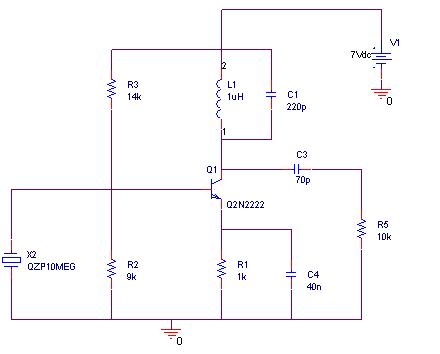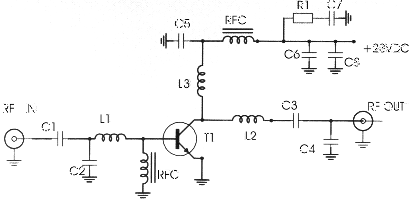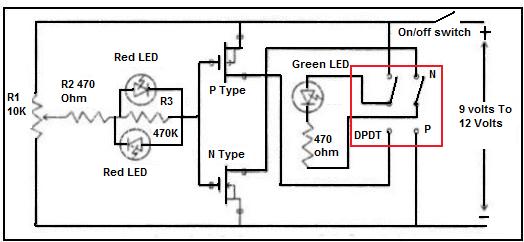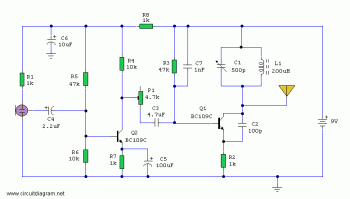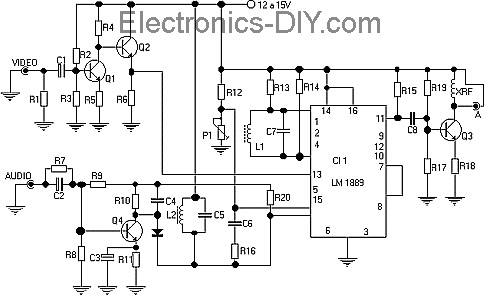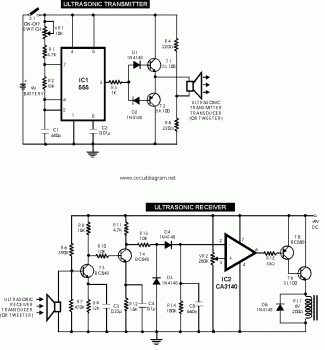
Test Transmitter
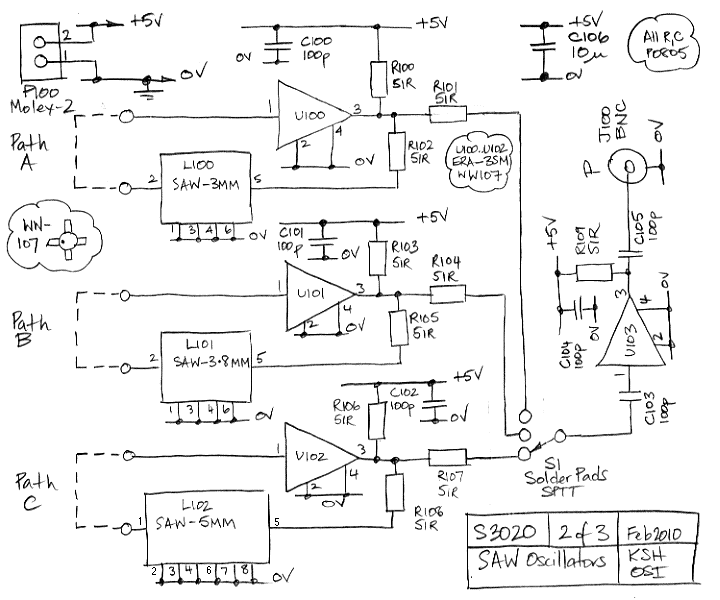
The Test Transmitter (A3020) is a combination of three circuits designed to test the Subcutaneous Transmitter (A3019) and to analyze surface acoustic wave (SAW) voltage-controlled oscillators (VCOs). The A3020 incorporates the complete A3019 circuit in its central section, which closely resembles that of the Subcutaneous Transmitter (A3013). Key modifications include the replacement of the reed switch with a Hall Effect switch, as the former was prone to damage and has been discontinued by the manufacturer. The magnetic switch powers down the circuit except for the Hall Effect switch, allowing the transmitter to operate in either an ON or OFF state. In the OFF state, only the Hall Effect switch draws current. In the ON state, the transmitter is active. The circuit employs two operational amplifiers for amplification and filtering, reducing the DC gain of the main amplifier stage by adding a capacitor to its feedback loop. This capacitor establishes a lower limit for the operating bandwidth at approximately 1 Hz. Power supply decoupling is optimized for analog circuits; the battery and regulator directly supply the analog circuits, while current to the digital circuits and VCO is supplied through resistors that minimize transmission noise in the analog supplies. The SAW VCO circuits build upon previous work with the RF Tester (A3014) and RF Combo (A3016) circuits, allowing for variations in feedback track length to induce oscillations and enabling shorting of a stub track to ground to effect phase changes. The A3020A circuit includes three sections: the central section contains the test transmitter circuit (S3020_1), the right section, which is independent, provides the SAW oscillator (S3020_2), and the left section utilizes signals from the logic chip in the test transmitter (S3020_3).
The Hall Effect switch comprises resistors and capacitors, including R1, C1, U1, U2, and C2 (see S3020_1). Component U1 is an A1171 Hall Effect sensor with a quiescent consumption of a few microamps. It activates for 80 microseconds out of every 60 milliseconds, corresponding to a switching frequency of approximately 18 Hz. With R1 set to 50 kΩ and C1 to 4.7 µF, a 100 mV linear drop is observed at U1-6 during the active phase, indicating a current of 5.9 mA from C1. After the active period, the voltage at U1-6 rises with a time constant around 30 milliseconds, consistent with the RC time constant of 50 kΩ and 4.7 µF, which equals 24 ms. The average voltage drop across R1 is measured at 280 mV with a 10 MΩ, G=10 probe, indicating an average current of 5.6 µA. A digital voltmeter (DVM) measures 5.3 µA after accounting for a 0.2 µA offset. When using a 1 MΩ, G=1 probe, a 420 mV drop occurs due to the probe's current draw, resulting in a total of 8.4 µA. Notably, the current measured by the DVM increases to 5.6 µA when R1 is touched with the G=10 probe. The voltage on VBAT shows a 0.5 mV drop over 5 ms, synchronized with U1's active period, followed by a rise of 0.5 mV over 55 ms. Initially, R1 was set to 1 kΩ, but this value led to a 50 mV noise on VBAT due to current surges through U1. Increasing R1 to 50 kΩ resulted in unreliable activation of U1 upon power connection, causing it to draw 40 µA with approximately 1.5 V across R1. A short across R1 using tweezers was necessary to initiate normal operation. When a magnet approaches U1, it triggers U2, a D-type flip-flop. The output from U1 (U1-1) toggles between low (0 V) and high (VBAT), serving as the power source for the entire transmitter circuit, which is decoupled with C2, a 4.7 µF capacitor. The internal switching frequency of U1 at 18 Hz may introduce noise into the transmitter amplifiers, but with proper functioning of C1 and R1, the amplitude of this noise at the input remains below 5 µA.The Test Transmitter (A3020) is a combination of three circuits. Its purpose is to allow us to test the Subcutaneous Transmitter ( A3019 ) and to investigate SAW (surface acoustic wave) VCOs (voltage-controlled oscillators). The A3020 contains the complete A3019 circuit in its center section. The circuit is almost identical to that of the Subcutan eous Transmitter ( A3013 ). The most significant changes are as follows. Replace reed switch with Hall Effect Switch. The old magnetic switch was easy to break and large, not to mention its being discontinued by the manufacturer. Magnet turns off all power to circuit except Hall Effect Switch. The transmitter is either ON or OFF. When it`s OFF, the only current drain is the Hall Effect Switch. When it is ON, it is transmitting. Two op-amps used for amplification and filtering instead of three. We reduce the DC gain of the main amplifier stage by adding a capacitor to its feeback loop. The capacitor sets the lower limit of the operating bandwidth at around 1 Hz. Power supply decoupling done so as to favor analog circuits. We use the battery and regulator directly for analog circuits, and supply current to the digital circuits and VCO through resistors that keep transmission noise off the analog supplies.
The SAW VCO circuits continue the earlier work we did with our RF Tester ( A3014 ) and RF Combo ( A3016 ) circuits. In the new SAW circuits, we are able to vary the feedback track length in order to provoke oscillations, and we are able to short a stub track to ground in order to cause phase changes.
Figure: The A3020A Circuit. The middle section provides the circuit drawn in S3020_1, the test transmitter. The right section, which we have cut off because it is independent, provides S3020_2, the SAW oscillator. The left section uses signals from the logic chip in the test transmitter, and provides S3020_3. [26-FEB-10] The Hall Effect Switch consists of R1, C1, U1, U2, and C2 (see S3020_1 ). Component U1 is a A1171 Hall Effect sensor. Its quiescent consumption is a few microamps. It turns on for 80 s out of every 60 ms (roughly 18 Hz switching). With R1 = 50 k © and C1 = 4. 7 F, we see a 100-mV linear drop on at U1-6 during the active period, or 1. 2 V/ms, which indicates 5. 9 mA out of C1. After the active period, the voltage on U1-6 rises with a time constant of around 30 ms, which is consistent with RC = 50 k © G— 4.
7 F = 24 ms. The average voltage drop across R1, meanwhile, is 280 mV when measured with a 10-M ©, G—10 probe, indicating an average current of 5. 6 A. Our DVM measures 5. 3 A (after subtracting 0. 2- A offset). If we use a 1-M ©, G—1 probe to measure the voltage drop, we see 420-mV drop because of current drawn by the probe, bringing the total to 8.
4 A. The current measured by our DVM increases to 5. 6 A when we touch R1 with the G—10 probe. On VBAT, we see a 0. 5-mV drop over 5 ms synchronous with the active period of U1. After that, VBAT rises 0. 5 mV over 55 ms. At first, we had R1 = 1 k ©, but with this smaller value we saw 50-mV of noise on VBAT as a result of the current surges through U1. We increased R1 to 50 k ©. But we now find that U1 does not turn on reliably when we connect power. It will get stuck consuming 40 A, with roughly 1. 5 V across R1. We must short R1 with tweezers to get the chip to start up, after which it runs normally. When we move a magnet near U1, it turns clocks U2, which is a D-type flip flop. The output of U1, which is U1-1, toggles between LO, or 0V, and HI, or VBAT. We use U1-1 as our source of power for the entire transmitter circuit, and decouple it with C2, a 4. 7 F capacitor. The 18-Hz internal switching frequency of U1 is a potential source of 18-Hz noise in the transmitter amplifiers.
With C1 and R1 functioning correctly, the amplitude of this noise at the input is less than 5 A. Table: Subcutaneous Transmitter Current Consumption. In each case we allow the circuit to 🔗 External reference
The Hall Effect switch comprises resistors and capacitors, including R1, C1, U1, U2, and C2 (see S3020_1). Component U1 is an A1171 Hall Effect sensor with a quiescent consumption of a few microamps. It activates for 80 microseconds out of every 60 milliseconds, corresponding to a switching frequency of approximately 18 Hz. With R1 set to 50 kΩ and C1 to 4.7 µF, a 100 mV linear drop is observed at U1-6 during the active phase, indicating a current of 5.9 mA from C1. After the active period, the voltage at U1-6 rises with a time constant around 30 milliseconds, consistent with the RC time constant of 50 kΩ and 4.7 µF, which equals 24 ms. The average voltage drop across R1 is measured at 280 mV with a 10 MΩ, G=10 probe, indicating an average current of 5.6 µA. A digital voltmeter (DVM) measures 5.3 µA after accounting for a 0.2 µA offset. When using a 1 MΩ, G=1 probe, a 420 mV drop occurs due to the probe's current draw, resulting in a total of 8.4 µA. Notably, the current measured by the DVM increases to 5.6 µA when R1 is touched with the G=10 probe. The voltage on VBAT shows a 0.5 mV drop over 5 ms, synchronized with U1's active period, followed by a rise of 0.5 mV over 55 ms. Initially, R1 was set to 1 kΩ, but this value led to a 50 mV noise on VBAT due to current surges through U1. Increasing R1 to 50 kΩ resulted in unreliable activation of U1 upon power connection, causing it to draw 40 µA with approximately 1.5 V across R1. A short across R1 using tweezers was necessary to initiate normal operation. When a magnet approaches U1, it triggers U2, a D-type flip-flop. The output from U1 (U1-1) toggles between low (0 V) and high (VBAT), serving as the power source for the entire transmitter circuit, which is decoupled with C2, a 4.7 µF capacitor. The internal switching frequency of U1 at 18 Hz may introduce noise into the transmitter amplifiers, but with proper functioning of C1 and R1, the amplitude of this noise at the input remains below 5 µA.The Test Transmitter (A3020) is a combination of three circuits. Its purpose is to allow us to test the Subcutaneous Transmitter ( A3019 ) and to investigate SAW (surface acoustic wave) VCOs (voltage-controlled oscillators). The A3020 contains the complete A3019 circuit in its center section. The circuit is almost identical to that of the Subcutan eous Transmitter ( A3013 ). The most significant changes are as follows. Replace reed switch with Hall Effect Switch. The old magnetic switch was easy to break and large, not to mention its being discontinued by the manufacturer. Magnet turns off all power to circuit except Hall Effect Switch. The transmitter is either ON or OFF. When it`s OFF, the only current drain is the Hall Effect Switch. When it is ON, it is transmitting. Two op-amps used for amplification and filtering instead of three. We reduce the DC gain of the main amplifier stage by adding a capacitor to its feeback loop. The capacitor sets the lower limit of the operating bandwidth at around 1 Hz. Power supply decoupling done so as to favor analog circuits. We use the battery and regulator directly for analog circuits, and supply current to the digital circuits and VCO through resistors that keep transmission noise off the analog supplies.
The SAW VCO circuits continue the earlier work we did with our RF Tester ( A3014 ) and RF Combo ( A3016 ) circuits. In the new SAW circuits, we are able to vary the feedback track length in order to provoke oscillations, and we are able to short a stub track to ground in order to cause phase changes.
Figure: The A3020A Circuit. The middle section provides the circuit drawn in S3020_1, the test transmitter. The right section, which we have cut off because it is independent, provides S3020_2, the SAW oscillator. The left section uses signals from the logic chip in the test transmitter, and provides S3020_3. [26-FEB-10] The Hall Effect Switch consists of R1, C1, U1, U2, and C2 (see S3020_1 ). Component U1 is a A1171 Hall Effect sensor. Its quiescent consumption is a few microamps. It turns on for 80 s out of every 60 ms (roughly 18 Hz switching). With R1 = 50 k © and C1 = 4. 7 F, we see a 100-mV linear drop on at U1-6 during the active period, or 1. 2 V/ms, which indicates 5. 9 mA out of C1. After the active period, the voltage on U1-6 rises with a time constant of around 30 ms, which is consistent with RC = 50 k © G— 4.
7 F = 24 ms. The average voltage drop across R1, meanwhile, is 280 mV when measured with a 10-M ©, G—10 probe, indicating an average current of 5. 6 A. Our DVM measures 5. 3 A (after subtracting 0. 2- A offset). If we use a 1-M ©, G—1 probe to measure the voltage drop, we see 420-mV drop because of current drawn by the probe, bringing the total to 8.
4 A. The current measured by our DVM increases to 5. 6 A when we touch R1 with the G—10 probe. On VBAT, we see a 0. 5-mV drop over 5 ms synchronous with the active period of U1. After that, VBAT rises 0. 5 mV over 55 ms. At first, we had R1 = 1 k ©, but with this smaller value we saw 50-mV of noise on VBAT as a result of the current surges through U1. We increased R1 to 50 k ©. But we now find that U1 does not turn on reliably when we connect power. It will get stuck consuming 40 A, with roughly 1. 5 V across R1. We must short R1 with tweezers to get the chip to start up, after which it runs normally. When we move a magnet near U1, it turns clocks U2, which is a D-type flip flop. The output of U1, which is U1-1, toggles between LO, or 0V, and HI, or VBAT. We use U1-1 as our source of power for the entire transmitter circuit, and decouple it with C2, a 4. 7 F capacitor. The 18-Hz internal switching frequency of U1 is a potential source of 18-Hz noise in the transmitter amplifiers.
With C1 and R1 functioning correctly, the amplitude of this noise at the input is less than 5 A. Table: Subcutaneous Transmitter Current Consumption. In each case we allow the circuit to 🔗 External reference
